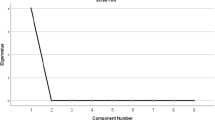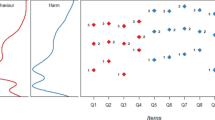Abstract
The purpose of this study was to examine the psychometric properties of the Chinese 9-item Problem Gambling Severity Index (PGSI) derived from the 31-item Canadian Problem Gambling Index (CPGI) originally developed by Ferris and Wynne (2001). Exploratory factor analysis (EFA; n = 386; Group A data) and confirmatory factor analysis (CFA; n = 387; Group B data) on the Chinese student and community data (Mean age = 25.36 years) showed that a unifactorial model fitted the data with good reliability score (Cronbach’s alpha = 0.77). The concurrent validity of the PGSI-C was good in terms of the Chinese data matching the expected correlation between PGSI-C and other variables or scales such as SOGS, gambling frequency, gambling urge, gambling cognitions, depression, anxiety, and stress. The scale also reported good discriminant and predictive validity. In sum, the PGSI-C has good psychometric properties and can be used among Chinese communities to identify at-risk problem gamblers. Implications and suggestions for future research are discussed.

Similar content being viewed by others
References
American Psychiatric Association. (2000). Diagnostic and statistical manual of mental disorders: DSM-IV-TR (4th, text revision edn.). Washington, DC: American Psychiatric Association.
Antony, M. M., Bieling, P. J., Cox, B. J., Enns, M. W., & Swinson, R. P. (1998). Psychometric properties of the 42-item and 21-item versions of the Depression Anxiety Stress Scales in clinical groups and a community sample. Psychological Assessment, 10(2), 176–181.
Arthur, D., Tong, W. L., Chen, C. P., Hing, A. Y., Sagara-Rosemeyer, M., Kua, E. H., et al. (2008). The validity and reliability of four measures of gambling behaviour in a sample of Singapore university students. Journal of Gambling Studies, 24(4), 451–462.
Blaszczynski, A., Huynh, S., Dumlao, V. J., & Farrell, E. (1998). Problem gambling within a Chinese speaking community. Journal of Gambling Studies, 14(4), 359–380.
Blunch, N. L. (2008). Introduction to structural equation modelling using SPSS and AMOS. Los Angeles: Sage.
Bolen, D. W., & Boyd, W. H. (1968). Gambling and the gambler: A review and preliminary findings. Archives of General Psychiatry, 18(5), 617–629.
Brace, N., Kemp, R., & Snelgar, R. (2009). SPSS for psychologists. Hampshire: Palgrave Macmillan.
Brooker, I. S., Clara, I. P., & Cox, B. J. (2009). The Canadian Problem Gambling Index: Factor structure and associations with psychopathology in a nationally representative sample. Canadian Journal of Behavioural Science, 41(2), 109–114.
Chen, C. N., Wong, J., Lee, N., Chan-Ho, M. W., Lau, J. T. F., & Fung, M. (1993). The Shatin community mental health survey in Hong Kong: II Major findings. Archives of General Psychiatry, 50(2), 125–133.
Clarke, D., Abbott, M., Tse, S., Townsend, S., Kingi, P., & Manaia, W. (2006). Gender, age, ethnic and occupational associations with pathological gambling in a New Zealand urban sample. New Zealand Journal of Psychology, 35(2), 84–91.
Ferris, J., & Wynne, H. (2001). The Canadian problem gambling index: Final report. Ottawa (ON): Canadian Centre on Substance Abuse.
Field, A. (2000). Discovering statistics using SPSS (3rd ed.). London: Sage.
Field, A. (2009). Discovering statistics using SPSS (3rd ed.). London: Sage.
Fong, D. K., & Ozorio, B. (2005). Gambling participation and prevalence estimates of pathological gambling in a far-east city: Macao. UNLV Gaming Research & Review Journal, 9, 15–28.
Hobson, J. S. P. (1995). Macao: Gambling on its future. Tourism Management, 16(3), 237–243.
Illinois Institute for Addiction Recovery. (2007). Addiction information. Retrieved from http://www.addictionrecov.org/aboutgam.htm.
Kline, P. (1994). An easy guide to factor analysis. London: Routledge.
Lai, D. W. L. (2006). Gambling and the older Chinese in Canada. Journal of Gambling Studies, 22(1), 121–141.
Lesieur, H. R., & Blume, S. B. (1987). The South Oaks Gambling Screen (SOGS): A new instrument for the identification of pathological gamblers. American Journal of Psychiatry, 144(9), 1184–1188.
Loo, J. M. Y., Raylu, N., & Oei, T. P. S. (2008). Gambling among the Chinese: A comprehensive review. Clinical Psychology Review, 28(7), 1152–1166.
Lovibond, P. F., & Lovibond, S. H. (1995). The structure of negative emotional states: Comparison of the Depression Anxiety Stress Scales (DASS) with the Beck Depression and Anxiety Inventories. Behaviour Research and Therapy, 33(3), 335–343.
McMillen, J., Marshall, D., Ahmed, E., & Wenzel, M. (2004). 2003 Victorian longitudinal community attitudes survey. Canberra, Australia: The Centre for Gambling Research, Australian National University.
McMillen, J., & Wenzel, M. (2006). Measuring problem gambling: Assessment of three prevalence screens. International Gambling Studies, 6(2), 147–174.
Neal, P., Delfabbro, P. H., & O’Neill, M. (2004). Problem gambling and harm: Towards a national definition. Melbourne: National Gambling Research Program Working Party.
Norton, P. J. (2007). Depression Anxiety and Stress Scales (DASS-21): Psychometric analysis across four racial groups. Anxiety, Stress & Coping: An International Journal, 20(3), 253–265.
Oei, T. P. S., Lin, J., & Raylu, N. (2007a). Validation of the Chinese version of the Gambling Related Cognitions Scale (GRCS-C). Journal of Gambling Studies, 23, 309–322.
Oei, T. P. S., Lin, J., & Raylu, N. (2007b). Validation of the Chinese version of the Gambling Urges Scale (GUS-C). International Gambling Studies, 7, 101–111.
Oei, T. P. S., Lin, J., & Raylu, N. (2008). The relationship between gambling cognitions, psychological states, and gambling: A cross-cultural study of Chinese and Caucasians in Australia. Journal of Cross-Cultural Psychology, 39(2), 147–161.
Parker, G., Gladstone, G., & Chee, K. T. (2001). Depression in the planet’s largest ethnic group: The Chinese. American Journal of Psychiatry, 158(6), 857–864.
Petry, N. M. (2005a). Pathological gambling: Etiology, comorbidity, and treatment. Washington, DC: American Psychological Association.
Petry, N. M. (2005b). Prevention: Focus on gambling in youth and young adults. In N. M. Petry (Ed.), Pathological gambling: Etiology, comorbidity, and treatment (pp. 269–278). Washington, DC: American Psychological Association.
Queensland Treasury. (2006). Queensland household gambling survey 2003–04. Brisbane: Queensland Government.
Raylu, N., & Oei, T. P. S. (2002). Pathological gambling: A comprehensive review. Clinical Psychology Review, 22(7), 1009–1061.
Raylu, N., & Oei, T. P. S. (2004). Role of culture in gambling and problem gambling. Clinical Psychology Review, 23(8), 1087–1114.
Rosenthal, R. J. (2003). Distribution of the DSM-IV criteria for pathological gambling. Addiction, 98(12), 1674–1675.
Roy Morgan Research. (2006). The fourth study into the extent and impact of gambling in Tasmania with particular reference to problem gambling: Follow-up to the studies conducted in 1994, 1996, and 2000. Hobart, Tasmania: Gambling Support Bureau, Department of Health and Services.
Shaffer, H. J., & Hall, M. N. (1996). Estimating the prevalence of adolescent gambling disorders: A quantitative synthesis and guide toward standard gambling nomenclature. Journal of Gambling Studies, 12(2), 193–214.
Stinchfield, R. (2002). Reliability, validity, and classification accuracy of the South Oaks Gambling Screen (SOGS). Addictive Behaviors, 27(1), 1–19.
Tabachnick, B. G., & Fidell, L. S. (2007). Using multivariate statistics (5th ed.). Boston: Pearson.
Tang, C. S., Wu, A. M. S., & Tang, J. Y. C. (2007). Gender differences in characteristics of Chinese treatment-seeking problem gamblers. Journal of Gambling Studies, 23(2), 145–156.
Tang, C. S., Wu, A. M. S., Tang, J. Y. C., & Yan, E. C. W. (2010). Reliability, validity, and cut scores of the South Oaks Gambling Screen (SOGS) for Chinese. Journal of Gambling Studies, 26(1), 145–158.
Tseng, W. S., Lin, T. Y., & Yeh, E. K. (1995). Chinese societies and mental health. Hong Kong: Oxford University Press.
Victorian Casino and Gaming Authority. (2000). The impact of gaming on specific cultural groups report. Melbourne, Victoria.
Vong, F. (2007). The psychology of risk-taking in gambling among Chinese visitors to Macau. International Gambling Studies, 7(1), 29–42.
Wenzel, M., McMillen, J., Marshall, D., & Ahmed, E. (2004). Validation of the Victorian gambling screen. Melbourne: Centre for Gambling Research (CGR), ANU.
Wong, I. L. K., & So, E. M. T. (2003). Prevalence estimates of problem and pathological gambling in Hong Kong. American Journal of Psychiatry, 160(7), 1353–1354.
Young, M., & Stevens, M. (2008). SOGS and CGPI: Parallel comparison on a diverse population. Journal of Gambling Studies, 24(3), 337–356.
Author information
Authors and Affiliations
Corresponding author
Rights and permissions
About this article
Cite this article
Loo, J.M.Y., Oei, T.P.S. & Raylu, N. Psychometric Evaluation of the Problem Gambling Severity Index-Chinese Version (PGSI-C). J Gambl Stud 27, 453–466 (2011). https://doi.org/10.1007/s10899-010-9221-1
Published:
Issue Date:
DOI: https://doi.org/10.1007/s10899-010-9221-1




